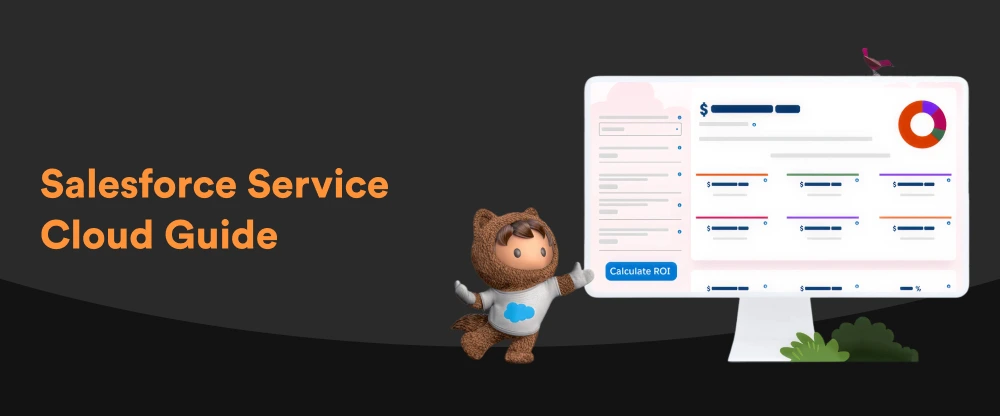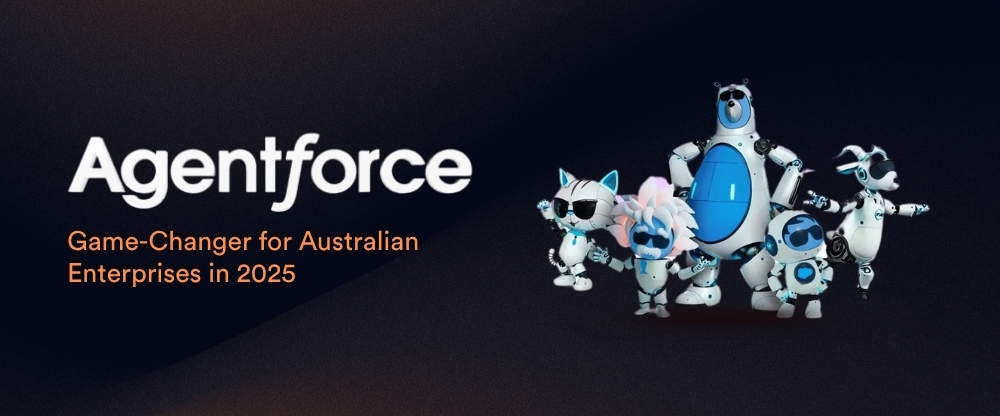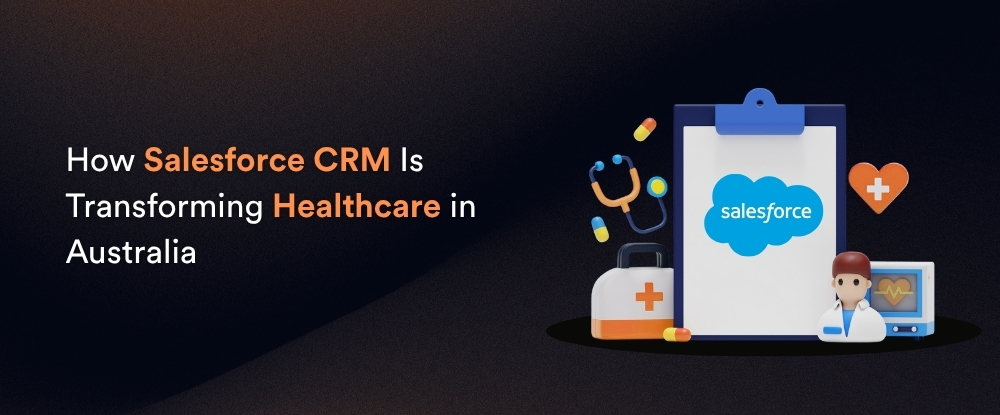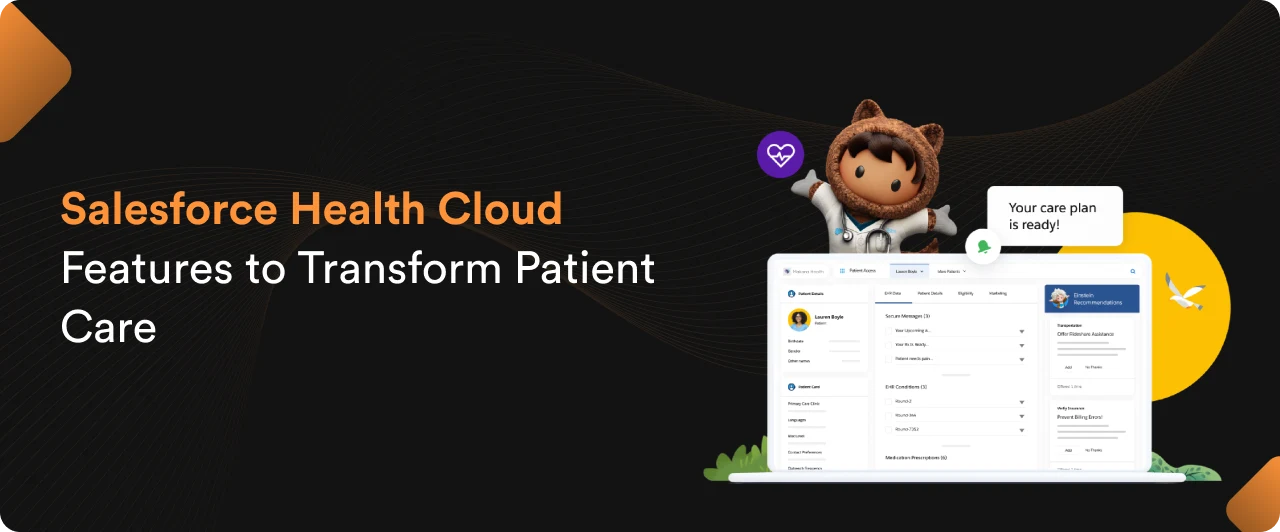
Salesforce Health Cloud Features to Transform Patient Care
Australian healthcare providers face a real problem. Patients now want the digital experience they get from banking or shopping apps. Smooth, fast, and easy-to-use. However, most healthcare platforms and digital solutions struggle with outdated features.
The result? Frustrated staff, annoyed patients, and information that gets lost in the shuffle.
Salesforce Health Cloud brings the perfect solution. It’s a platform built specifically for healthcare organisations that need to connect patient data, streamline communication, and actually deliver better care.
Getting it set up properly matters, though. Working with Salesforce consulting companies means the difference between a tool that sits unused and one that transforms how care gets delivered.
What Is Salesforce Health Cloud?

Think of it as a central hub for everything patient-related. Health Cloud sits on top of Salesforce’s CRM technology but adds all the healthcare-specific features that generic business software misses.
The big win? Everyone sees the same patient information. Doctors, nurses, admin staff, and care coordinators can simply refer to one database instead of accessing scattered systems.
Australian providers need to worry about compliance, too. A good Salesforce consultant Sydney will configure the platform to handle Privacy Act requirements, integrate with My Health Records, and meet whatever state-specific rules apply. That’s not optional, it’s fundamental.
8 Features That Change How Healthcare Works
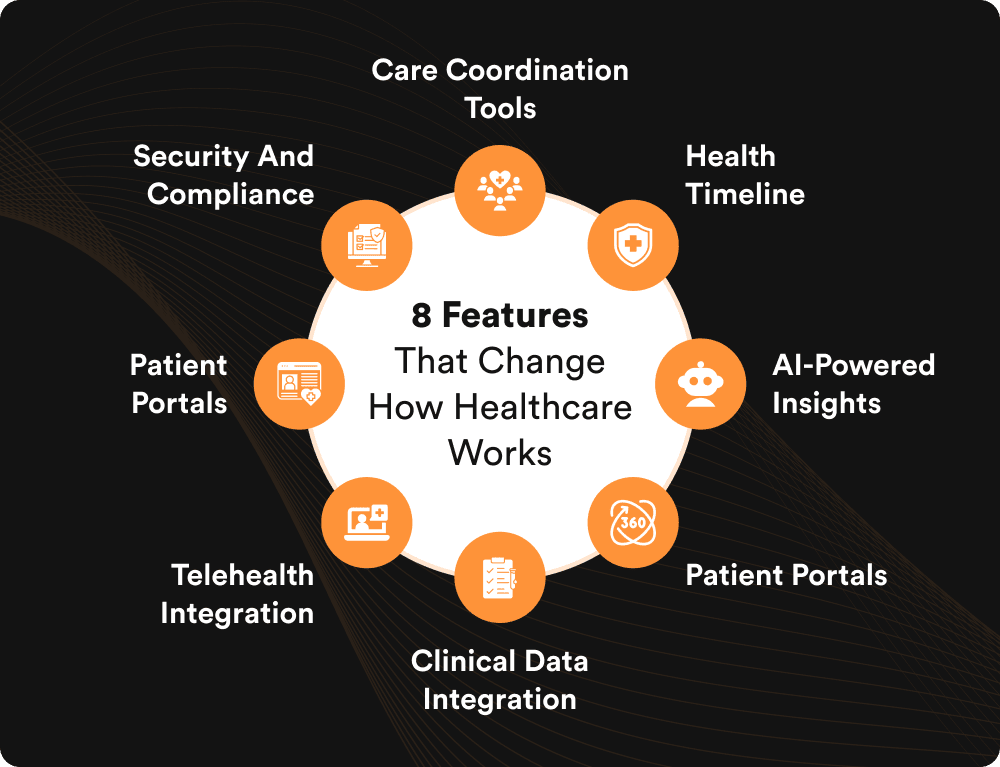
1. 360-Degree Patient View
Every interaction, appointment, prescription, and phone call lives in one place. Medical history, patient’s communication preferences, and health-impacting social factors are all stored in a central database.
A doctor can see that a patient missed their last three appointments, not because they don’t care, but because they struggle with transportation. That context matters.
2. Care Coordination Tools
Healthcare isn’t a solo sport. Multiple people touch every patient’s care journey.
Health Cloud gives teams a shared workspace. Assign tasks to specific people. Track what’s been done and what’s pending. When something changes, everyone who needs to know gets notified automatically. No more wondering if the message got passed along.
3. Health Timeline
Imagine scrolling through years of medical history like a social media feed. Every diagnosis, treatment, hospital visit, and test result appears chronologically.
Doctors spot patterns faster. Recurring symptoms become obvious. Treatment responses show up clearly. It beats flipping through paper charts or clicking through endless screens in an old EHR system.
4. Clinical Data Integration
Health Cloud doesn’t replace existing EHR systems. It connects to them.
Data flows in both directions automatically. Update a medication in the EHR? It appears in Health Cloud. Schedule an appointment in Health Cloud? It shows up in the EHR. Clinical teams keep using familiar tools while everyone benefits from connected information.
5. AI-Powered Insights
The platform watches for warning signs. Which patients haven’t shown up for preventive care? Who’s at risk of hospital readmission? Where should care coordinators focus their limited time?
Machine learning analyzes thousands of data points and presents these insights. Care teams can act before minor issues turn into emergencies. That’s the difference between reactive and proactive healthcare.
6. Patient Portals
Most people prefer handling simple tasks themselves. Check test results. Message their doctor with a quick question. Book their next appointment. Refill a prescription.
Portals make this possible 24/7. Patients get faster answers. Staff spend less time on routine phone calls. Everyone wins.
7. Telehealth Integration
Virtual care isn’t going anywhere. For regional and remote Australia, it’s often the only practical option.
Health Cloud includes telehealth functionality built right in. Video consultations happen within the platform. Notes go straight into the patient record. Follow-ups can be virtual or in-person, based on what makes sense. Geography becomes less of a barrier.
8. Security and Compliance
Patient data protection runs constantly in the background. Encryption. Access controls. Audit trails that track every interaction.
The system handles Australian privacy standards and international healthcare regulations automatically. Compliance stops being a separate project and becomes part of how the platform operates.
Why Healthcare Organisations Are Making the Switch?

Old systems create busywork. The improvements show up in multiple ways:
- Less time on admin means more time with patients
- Better coordination leads to better outcomes
- Security becomes automatic instead of something to worry about
- Data actually helps make decisions instead of sitting unused
Small practices and large hospital networks both see the benefits. The platform scales to fit.
Old Systems vs Health Cloud
Traditional Approach | Traditional Approach | Health Cloud |
Patient data | Scattered across multiple systems | One unified view |
Team communication | Phone calls, emails, sticky notes | Automated notifications and shared workspaces |
Growth | Expensive and complicated to expand | Add users and locations as needed |
Analytics | Reports on what already happened | Predictions about what’s coming |
Patient engagement | Office hours phone calls | 24/7 self-service access |
🎧 Podcast: School Management Tech That Actually Works in Australia

Prefer listening? In this episode, our ed-tech experts break down how school management systems are helping Australian schools move beyond paper trails and email chains. We talk about the real-time benefits, common implementation mistakes, and how digital tools are transforming teaching and admin alike.
🎙️ Tune in for practical insights on future-proofing your school.
Working with the Right Salesforce Consultant in Sydney
Healthcare technology projects fail more often than they should.
Experienced Salesforce consulting companies avoid these pitfalls. They configure the platform to match how care teams actually work. They connect to existing EHR systems without causing chaos. They train people on features that matter for their specific roles.
Local knowledge counts for a lot. A Salesforce consultant in Sydney understands Australian healthcare regulations and privacy laws. They set up systems that align with the local context.
That expertise leads to faster and better implementation, fewer problems, and more desirable long-term results.
Conclusion
Healthcare is changing fast. Patients expect digital convenience. Regulations demand better data security. Rising costs require operational efficiency. Salesforce Health Cloud connects information, coordinates teams, and creates clear communication, all in one secure platform.
Frequently Asked Questions (FAQs)
The platform centers around eight main features:
- a complete 360-degree patient view,
- care coordination tools for team collaboration,
- a visual health timeline,
- EHR integration,
- AI-powered risk detection,
- patient self-service portals,
- built-in telehealth, and
- automatic compliance management.
Secure portals let patients access their own information. They can view test results, message their care team, or book appointments from their homes without playing phone tag during business hours.
Yes, and that’s actually one of its strengths. Health Cloud connects directly to existing EHR systems without replacing them. Data flows automatically between platforms.
The benefits stack up quickly. Administrative work decreases through automation. Care coordination becomes easier with shared workspaces. Teams make better decisions using AI insights. And patients have better experiences.
They bring healthcare expertise that goes beyond just knowing the software. Good consultants configure the platform to match actual workflows. A Salesforce consultant in Sydney also ensures the setup meets Australian compliance requirements from day one.



